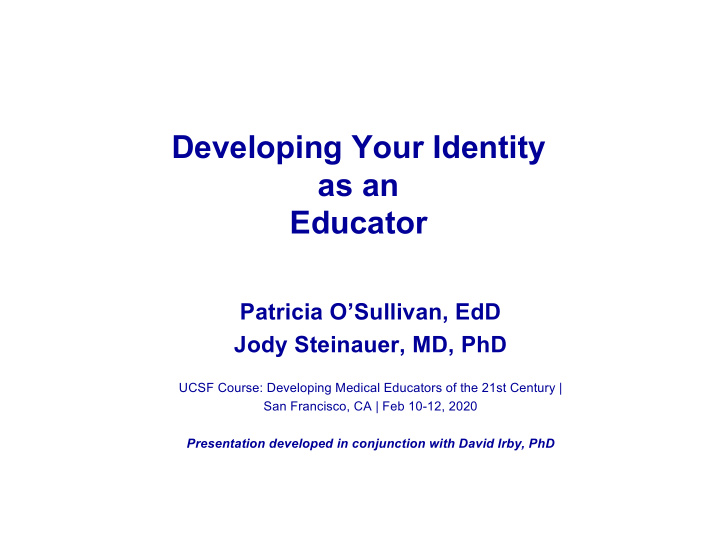



Developing Your Identity as an Educator Patricia O’Sullivan, EdD Jody Steinauer, MD, PhD UCSF Course: Developing Medical Educators of the 21st Century | San Francisco, CA | Feb 10-12, 2020 Presentation developed in conjunction with David Irby, PhD
Overview Describe the role and importance of an individual’s professional Identify how identities these identities can be awakened, strengthened and suppported Develop personal plans to achieve alignment between competing elements
Who Am I? An Exercise Please introduce yourself to three people you do not know
Who Am I? An Exercise Please introduce yourself to three people you do not know Write down what you said
Multiple Identities Professional Personal Identities Identities Organizational Identities 1. Roccas, S. & Brewer M. B. Personality & Soc Psych Rev , 2002. 2. Monrouxe LV. Identity, identification and medical education: why should we care? Med Educ . 2010.
Identity Theory • Describes how people view themselves and how they perceive others view them as • Derived from perceived membership in organizations (i.e., social identity) • Interacts with agency • Embodies multiple identities 1. Van Lankveld. Integrating the Teaching role into One’s Identity…Adv in Health Sci Educ. 2016. 2. Lawler. Identify: Sociological Perspectives . Cambridge, Polity Press. 2008. 3. Trede. Professional Identity Development: A Review of the Higher Education Literature. Studies Higher Educ . 2012.
Compartmentalized Identity “When I ’ m teaching in class, this is a separate Educator thing, because I have to be in a lecture room with students. But when I ’ m doing clinical teaching, I’ll be in the ward, so I’ll be providing medical Physician care.” O'Sullivan et al. Identity Formation and Motivation of New Faculty Developers. Med Teach. 38;879-885, 2016
Merged Identity “I think physician and medical educator are probably 50/50 – Physician Educator overlap, integrative, whatever we’re doing. And it’s hard to separate out the physician from the Scientist scientist” O'Sullivan, Irby. Identity Formation of Occasional Faculty Developers in Medical Education. Acad Med 89, 1467-73, 2014.
Single Role Identity MD/ Scientist
Role and Organization MD/ UCSF Scientist
Educator MD/ Scientist Hierarchical
Merged Personal MD
Construct a Venn diagram from your introduction Clinician Clinician Leader Educator Teacher Researcher Teacher/ Faculty Educator Mentor Clinician Developer/ Researcher Leader Researcher
Professional Identity Development • Is dynamic, constantly evolving • Is derived from observation and reflection • Interacts with – Organizations and context – Roles and their status/social privilege – Personal agency – Personal and professional knowledge, values 1. Beauchamp. Understanding Teacher Identity. Cambridge j of Educ. 2009. 2. Lieff. Who Am I? Key Influences on the Formation of Academic Identity... Med Teacher. 2012. 3. Trede. Professional Identity Development: A Review of the Higher Education Literature. Studies in Higher Educ . 2012.
Identity Formation Roles Context Identity I Feel I Feel Engaged Supported I Feel Agency Empowered Jauregui. Remooring: A Qualitative Focus Group Exploration of How Educators Maintain Identity. Acad Med, 2009.
Strategies for Exploring Identity 5 Minutes Step 1: Complete front of worksheet: Place checkmarks on specific items. 10 Minutes Step 2. Complete back of worksheet: Think about how you are engaged, empowered, supported as a medical educator. May need to re-do diagram. 15 Minutes Step 3. Discuss in small groups. Devise a plan for you to achieve alignment between role and context. How will you use agency to achieve this?
Summarizing Educator Identity Engage in educator roles Teaching, mentoring, curriculum development, learner assessment, educational leadership and scholarship Empower and exercise agency Psychological empowerment and agency Relational empowerment and networks Support from Academic environment Health care system context
Concluding Thought A strong professional identity enables individuals to practice with confidence and with a professional demeanour, thereby giving others confidence in their abilities. Monrouxe 2010 Thank you!
References • Beauchamp. Cambridge J of Educ. 39(2):175-189, 2009. • Cantillon et al. Adv in Health Sci Educ . Online, 2016. • Jauregui, et al. Acad Med , 2019. • Lawler. Sociological Perspectives, 2008. • Lieff et al. Med Teach . 34:e208-e215, 2012. • Lown et al. Acad Med . 84:1089-1097, 2009 • Monrouxe. Med Educ . 44(1):40-9, 2010. • O’Sullivan, et al. Acad Med . 86(4): 422-28, 2011. • O'Sullivan et al. Med Teach . 38;879-885, 2016 • O'Sullivan, Irby. Acad Med. 89, 1467-73, 2014.
References • Roccas, Brewer. Personality & Soc Psych Rev , 2002. • Steinert. Faculty Development in the Health Professions, 2014. • Steinert, MacDonald. Med Educ, 2015. • Stone et al. Med Educ . 36:180-185, 2002. • Trede et al. Studies in Higher Educ . 37(3):365-384, 2012. • Van Lankveld et al. H. Educ Res Dev, 2016. • Van Lankveld et al. Adv in Health Sci Educ . 21(6):1-22, 2016. • Wilkerson, Irby. Acad Med . 73(4):387-96, 1998.
Creative Commons License Attribution-NonCommercial-ShareAlike 2.0 You are free: • to copy, distribute, and display this presentation, and/or • to make derivative works Under the following conditions: • Attribution. You must give the original authors credit. • Noncommercial . You may not use this work for commercial purposes. • Share Alike . If you alter, transform, or build upon this work, you may distribute the resulting work only under a license identical to this one. See http://creativecommons.org/licenses/by-nc-sa/2.0/ for full license. 2/4/20
Recommend
More recommend